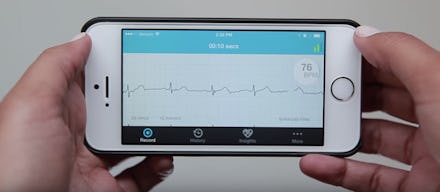Here's How Wearable Health Tech Could Save Us Time and Money

As wearable devices gain popularity, health care professionals are exploring how quantified self-data can encourage healthier living habits, detect acute medical problems the moment they surface and ultimately cut down on the cost of treatment.
One in 5 Americans owned a wearable device in 2014, according to a PwC survey. Out of those wearables, smartwatches and fitness trackers are some of the most common being used; 6.8 million smartwatches were sold in 2014 alone, according to the research company Smartwatch Group.
Changing behaviors: With these devices, people have the ability to download apps that can collect information about their daily eating and fitness habits, from how many calories they've consumed to their average heart rate during any given workout. Beyond helping wearers lose a few pounds, however, researchers believe these kinds of trackers can help to turn passive monitoring into active pursuit of healthy behavior.
"We know that self-monitoring is one of the most effective behavior change methods," Northwestern University professor of preventive medicine Bonnie Spring told Mic. "But people are really poor at doing self-monitoring. Wearable technology that monitors passively can offer a huge step forward in bolstering adherence to self-monitoring."
If logging what you're eating every day to meet a specific calorie count helps prevent overeating, it could also help prevent long-term health risks associated with obesity, like diabetes and heart complications.
"The popularity of physical activity monitors and their wide uptake by a substantial sector of the population holds the potential to actually shift much of our largely inactive community toward a higher level of activity," Spring said.
Simple calorie-counting apps and fitness logs are a start, but Spring is working to build more advanced devices that can prevent unhealthy behaviors like smoking and obesity. She was recently awarded a $10.8 million grant from the National Institutes of Health to continue that work.
"We're developing just-in-time interventions that learn about a patient's daily routines and habits to know when they're at risk even before they know it," she told Chicago Health.
Some devices already exist to combat these behaviors. SmartStop, created by Chrono Therapeutics, uses sensors to detect when a person is craving nicotine. It then gives the person a small, timely dose of medication to help them ease off the impulse to smoke a cigarette.
There are a number of apps that anyone with a smartphone or smartwatch can download to monitor food and exercise. With the devices that Spring is working on, data from the patient about diet and physical activity is transmitted to a person or avatar that gives feedback and then suggests changes to the user's behavior. She's already seeing tangible improvements.
"We have seen excellent clinical outcomes in terms of weight loss and weight loss maintenance, and in terms of large improvements in physical activity, decreased sedentary time, reduced saturated fat and increased fruit and vegetable intakes," she said.
Continuous and timely data: Because wearables can collect information about the people using them at all times, they present an opportunity to remotely monitor patients away from the hospital.
Unlike smartwatches and general fitness trackers, many wearables designed specifically to monitor health require approval from the Food and Drug Administration. However, consumer devices have the potential to greatly impact a patient's care by providing doctors with more constant information.
With continuous monitoring of patients instead of periodic testing in the hospital, doctors could reduce the cost of treatment by 10% to 20%, according to the McKinsey Global Institute. With more information, doctors could gain a better understanding of their patient's overall condition instead of relying on short one-off tests, anecdotal information from patients and patient advocates or a patient's symptoms the day of an exam.
Some devices are starting to provide these services. AliveCore takes remote electrocardiograms (ECGs) of your heart and records them in an app. It allows you to take notes about your heart condition so you can have more information to show the doctor between visits. HealthPatch MD keeps tabs on a patient's vital stats remotely, so doctors can know more about their patients even when they aren't in the office.
In terms of caring for a patient with a long-term health condition or an elderly person who needs constant care, devices that monitor everything from blood pressure to cardiac functions can give doctors more information while patients are at home. With more constant data, doctors can pick up on when emergency is happening faster or when a patient needs to come into the hospital to address a dramatic change in their condition.
"Inpatient hospitalization is very expensive," Spring said. "Excess cost occurs when we're not exactly sure when the patient is in a state of risk, so we keep them hospitalized longer than needed as a safety strategy. Being able to collect continuous big data that we can mine to learn accurately to predict when a risk period is about to occur is a hugely important opportunity."